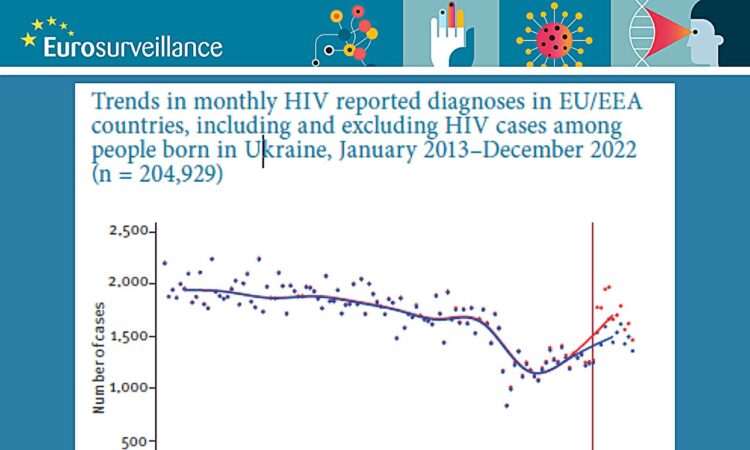
× close
Across the 30 countries of the European Union and European Economic Area (EU/EEA), 22,995 new HIV diagnoses were reported in 2022. Almost every second new HIV diagnosis (49%, n=11,103) was among migrants, i.e., among people who were not born in the country they were diagnosed in.
In the aftermath of Russia’s invasion of Ukraine in 2022, more than 4 million Ukrainians took refuge in countries of the European Union and European Economic Area (EU/EEA). In a rapid communication published in Eurosurveillance prior to World AIDS Day 2023 on 1 December, Reyes-Urueña et al. look at the most recent surveillance data to assess the potential impact on HIV case reporting in the region since the start of the war in Ukraine.
Based on 2022 data, EU/EEA countries have observed an increase in new HIV diagnoses, which is attributed to several factors, including restoring surveillance activities, scale-up and introduction of novel testing strategies in many countries, migration patterns, lifting of COVID-19 restrictions and the arrival of refugees. However, 10% of all new HIV diagnoses in the EU/EEA last year were made among Ukrainian refugees (n=2,338). This constitutes a 10-fold increase compared with 2021 (n=223).
Among the 2,338 Ukrainian refugees diagnosed with HIV in the EU/EEA in 2022, 9% (n=217) were diagnosed for the first time in the reporting country, while the majority (59%, n=1,368) had been notified about their HIV status before 2022. For around a third (32%), this information was unknown. Half of those who had previously been diagnosed with HIV were on antiretroviral treatment at the time of reporting in 2022.
Host countries need tailored early testing and treatment approaches
Overall, the EU/EEA notification rate of HIV cases in 2022 was 5.1 per 100,000 population, which constitutes a 31% increase compared with 2021 (3.9/100,000 population), but a decrease of 3.8% compared with 2019 (5.3/100,000 population).
In the group of Ukrainian people diagnosed with HIV, women are the most affected, accounting for the bigger part of new diagnoses (n=1,585) with heterosexual sex as the primary transmission mode.
The authors also highlight that “among cases with known data on previous diagnosis, the prevalence of late HIV diagnosis (47.0%) and AIDS (18.9%) among newly diagnosed people underscores the urgent need for tailored early testing and linking to care in host countries.”
According to Reyes-Urueña et al., the results of their study have important implications for HIV prevention, testing, treatment, stigma reduction and surveillance in EU/EEA countries: “Prevention that is accessible to new migrant populations, including pre-exposure prophylaxis for HIV (PrEP) as well as needle and syringe programs and drug treatment for people who use drugs are crucial, especially given that refugees have well-documented vulnerabilities that may incur higher HIV acquisition risk.”
More information:
Juliana Reyes-Urueña et al, HIV diagnoses among people born in Ukraine reported by EU/EEA countries in 2022: impact on regional HIV trends and implications for healthcare planning, EU/EEA, 2022, Eurosurveillance (2023). DOI: 10.2807/1560-7917.ES.2023.28.48.2300642
Provided by
European Centre for Disease Prevention and Control (ECDC)






